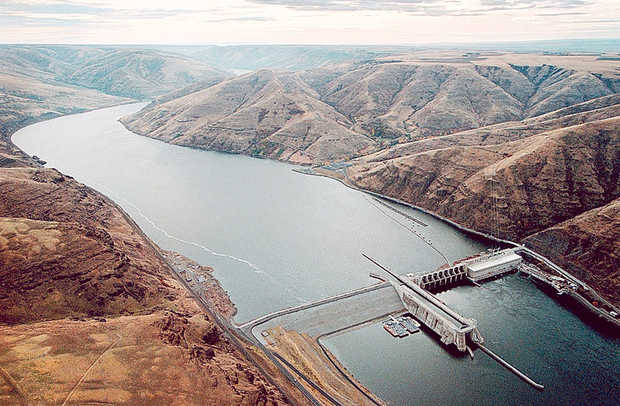forum
library
tutorial
contact

Washington State Expected
to Regulate Federal Dams
by Casey Leins
U.S. News & World Reports, February 19, 2019
|
the film forum library tutorial contact |

|
Washington State Expected
by Casey Leins
|
Experts say the dams, along with climate change, are heating the water and killing salmon.
 Washington state is expected to gain regulatory control over federal hydropower dams in the Columbia and Snake rivers, allowing the state to better protect its waters and restore its salmon population.
Washington state is expected to gain regulatory control over federal hydropower dams in the Columbia and Snake rivers, allowing the state to better protect its waters and restore its salmon population.
The dams are a major contributor to the rivers' high temperatures, which are killing the region's salmon populations. The dam operators have not had to follow state standards since they were built. Now, their operators might have to follow state guidelines for the first time, thanks to a lawsuit filed by an environmental group.
The nine federal dams in the Columbia and Snake rivers within the state of Washington were built before the Clean Water Act, which governs water pollution in the U.S. Until now, the federal dam operators have not been required to follow the law's standards and also haven't been required to adhere to the state's standards, which include pollution discharge limits and a temperature limit of 68 degrees in the Columbia River.
But Washington state might finally have its chance to regulate the federal dams, thanks to lawsuits filed by Columbia Riverkeeper, an organization dedicated to protecting and restoring the Columbia River. The organization reached a settlement in 2014 with the Army Corps of Engineers and the Bureau of Reclamation -- which operate the dams -- to reduce the dams' toxic oil pollution discharge.
The federal hydropower dam operators must now apply for discharge elimination permits from the Environmental Protection Agency for each federal dam. This is where Washington state enters the picture: The EPA must consult Washington's Department of Ecology to make sure its permits meet state standards.
According to The Seattle Times, the Environmental Protection Agency released a report attributing the Columbia and Snake rivers' temperature increase -- up 1.5 degrees Celsius since 1960 in some areas -- to both dams and climate change.
Dams raise the water temperature by slowing down the current. This forms stagnant reservoirs, which heat up under the sun. The Times reports that the rivers' temperatures sometimes surpass 70 degrees in some areas, which is both deadly to salmon, which are cold-water fish, and optimal for predators.
Heather Bartlett, who leads the Department of Ecology's water-quality program, describes the importance of salmon to Washington.
"Salmon are an iconic species to our region. They are a huge cultural value to the region, and we have been spending millions of dollars to rebuild and recover those populations, and it's been a huge challenge." She adds that the state's orca population, which relies on Chinook salmon for food, has also been suffering.
The state's Department of Ecology began a public comment period on Jan. 30 that allows citizens to view the EPA's requests for certification.
The Department of Ecology will review the applications and consider public comment before issuing the EPA a Section 401 Water Quality Certification (required for the permits to be issued) for each dam to indicate that the dam operations will be protective of Washington's standards, says Colleen Keltz, the Department of Ecology's water quality communications manager.
Even before the public comment period -- which ends Feb. 19 -- began, Bartlett says the department received letters from tribes and environmental groups expressing how they want to see Washington exercise its full authority to ensure the dams meet state standards.
But Bartlett says the EPA unexpectedly requested to withdraw its applications for the 401 certifications in a letter a couple weeks ago. Bartlett says her department sent a response letter reaffirming the EPA needs 401 certifications in order to distribute its permits for the dams.
It's a "very curious turn of events," she says.
The EPA told U.S. News in an email that it withdrew its requests for water quality certification because the agency determined its preliminary draft permits need additional review.
"We fully intend to reinitiate our requests for water quality certification after we have completed our internal review and updated the preliminary draft permits, as appropriate," the EPA said.
learn more on topics covered in the film
see the video
read the script
learn the songs
discussion forum
